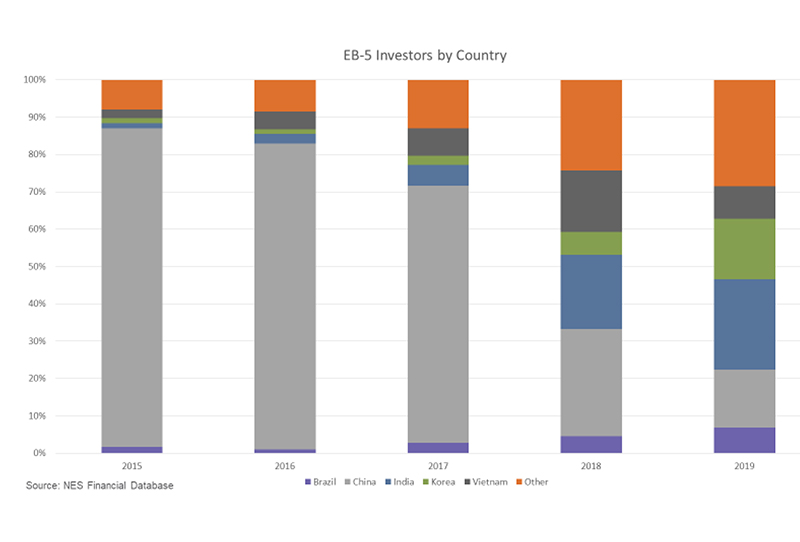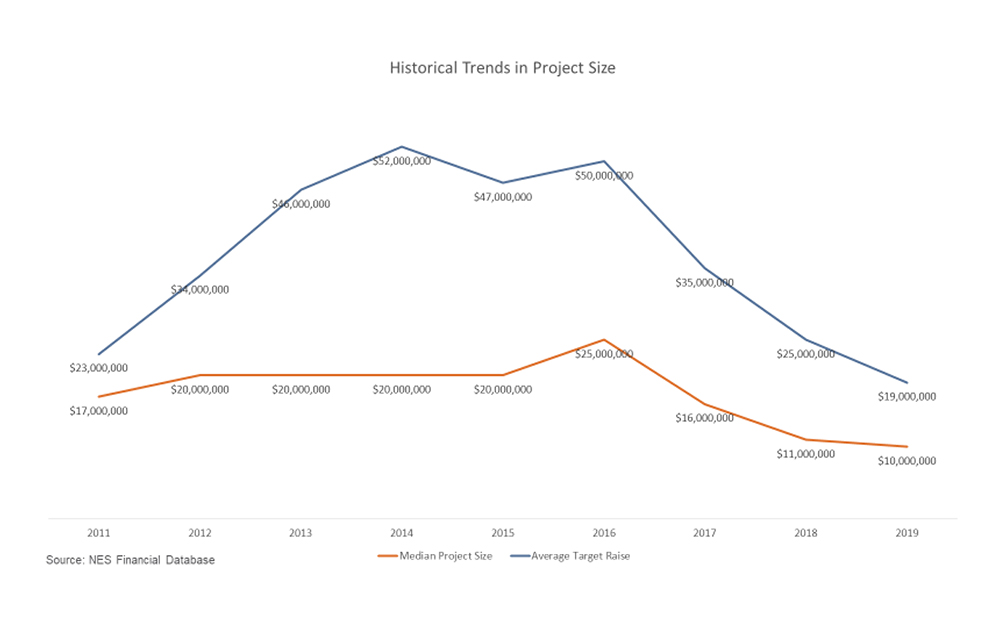EB-5 Version 3.0 Offers New Opportunities, Challenges
Despite negative rhetoric on immigration, global demand for U.S. citizenship seems to be at record highs, notes NES Financial's Reid Thomas.

Reid Thomas Image courtesy of NES Financial
The U.S. Citizenship and Immigration Services recently published new EB-5 regulations that go into effect on Nov. 21, 2019, and the EB-5 industry is abuzz on how it will affect the real estate sector. And what the future of the EB-5 program is and will look like.
The implementation of these regulations will begin a new era for the EB-5 program. I’m calling it EB-5 3.0. As you may recall, EB-5 2.0 was the last major shift in the use of the program, which began after the financial crisis. At that time, the program went from relative obscurity to becoming a mainstream source of capital in real estate development. This EB-5 2.0 era was characterized by massive inflows of capital which far exceeded the visa capacity of the program and mixed views on the program benefits. On the one hand, the 2013 Commerce Report EB-5 impact analysis supported that EB-5 had an enormous positive impact on job creation, yet on the other hand, the media headlines stirred debate regarding program integrity amidst several high-profile cases of fraud and abuse.
This article breaks down why we believe the EB-5 3.0 era will create significant changes and challenges for current operators, but will also create opportunities for those that can embrace the changes, adjust their offerings and re-commit to best practices.
U.S. Citizenship Still Most Valued
Despite negative rhetoric on immigration, global demand for United States citizenship seems to be at record highs as evidenced by record backlogs in immigration programs and reports of hundreds of thousands of migrants at our southern border. The slowdown in EB-5 over the last 24 months has nothing to do with the demand for immigration under the program, but has everything to do with the supply of visas available for qualified investors.
CanAm has been a leading Regional Centers operator in the U.S. for over 30 years and has worked with more than 5,500 EB-5 investors. They have helped create approximately 72,000 full-time new jobs in the U.S. and remain committed to the EB-5 program and helping foreign investors and their families.
“The desire of qualified immigrant families to make the U.S. their home through conservative job-creating investments, remains steadfast,” shared Tom Rosenfeld, President and CEO of CanAm Enterprises, a leading Regional Centers operator in the U.S.
Up until recently China had consumed the vast majority of the overall visas. However, once the capacity limits were reached, and wait lines began to increase for Chinese investors, the industry needed to search for interested investors in other countries.
China has historically been the largest source of EB-5 investors until recently. The chart below which is based on our data, shows the shifting trend toward other countries, including India, Korea and Brazil.

Some developers saw the growing importance of markets outside of China earlier than others. Driftwood Hospitality, an NES Financial client since 2014, was one of the first to seek investors in South America, specifically Brazil and Colombia and is one of the most successful in those markets as a result. Today, Driftwood, a leading hotel development and management company operating 70+ hotels with over 10,000 rooms throughout the United States and Costa Rica, still believes the EB-5 program is important and is planning future developments with investors from South America.
The Realities of Other Investor Markets
In addition to strong demand for EB-5 from Chinese investors, one of the great things about the China market is the existence of a sophisticated immigration agent network that helps find and educate potential investors about EB-5 and can introduce them to potential investment opportunities. This sophisticated channel facilitated the raising of large sums of EB-5 capital in relatively quick periods of time.
While the demand from other markets outside of China can also be strong, they lack this same channel infrastructure. This makes it more time consuming and difficult to find and educate investors. Those developers that made the transition early benefitted, but also had to adjust to a different model than what was typically done in China.
“We saw early on the importance of bringing investors from South America to help create jobs in the United States,” said Carlos J. Rodriguez, Jr., COO of Driftwood Acquisitions & Development. “We working closely with Brazilian and Colombian investors who are still very much interested in the EB-5 program. We intentionally designed our projects with the interests of investors from these markets in mind. Our projects are typically smaller than projects raising capital from China and are structured as equity platforms (as opposed to debt which is popular in China), making it possible for investors to generate a healthy return on their investment at the current levels and even with the increase in the investment minimum.”
As investment flow from markets outside of China increased, EB-5 project structures adapted to the market demands from these countries. The chart below shows the historical trends in project size. Beginning in 2015 when investment from other countries began to increase, projects were being structured for smaller EB-5 raises reflecting the realties of finding investors from these countries.

According to data NES Financial has collected, we saw trends as early as 2015 that projects are still getting funded, just at smaller rates. The median project size in 2015 was $20 million, and that figure has dropped to $10 million in 2019. Same for the average target raise, in 2015 it was $47 million, and this year has dropped to $19 million.
Changing Landscape for Developers Using EB-5
One important EB-5 regulation going into effect this November is the price increase in Target Employment Areas. A tiered system is already in place; however, $500,000 for a TEA-related project will become $900,000 effective on November 21, 2019. Non-TEA investments will increase from $1 million to $1.8 million.
Perhaps even more impactful is that the definition of a TEA has been changed to become much more restrictive. Under the new regulations, TEAs are approved by USCIS, removing this authority from the States. Additionally, whereas the definition of high unemployment areas typically won’t have a dramatic effect on rural areas, the definition will significantly change in urban settings. Formerly, it was possible to combine a number of contiguous census tracts to form a high unemployment area map; however, that will no longer be possible with the new updates to the EB-5 Program.
When the new regulations go into effect in November, many projects will no longer qualify for the lower investment amount and the developers will find themselves competing against projects with a significant minimum investment differential.
“We also anticipate that about 33 percent of EB-5 projects will still qualify for TEA status at the revised $900K investment threshold,” said Samuel B. Silverman, managing partner of EB5 Affiliate Network.
EB5 Affiliate Network, one of the most active EB-5 consulting firms and regional centers operators in the U.S., believes that the market is evolving and that it will still be a viable source of financing even after the changes.
“Post the Nov. 21, 2019 regulatory changes, EB-5 financing will continue to be a significant source of investment capital in U.S. real estate development markets with a shift toward more institutional developments and smaller, friends and family transactions where there is minimal demand elasticity given the price increase from $500,000 to $900,000,” added Silverman.
For CanAm Enterprises, they are aware of the changes coming in November and are prepared for the new regulations. “As intended, the proposed regulations create new incentives that will redirect the focus of the EB-5 projects CanAm sponsors,” said CanAm Enterprises’ Rosenfeld.
The Silver Lining
The price increase already discussed can have a silver lining. It will be easier to get job counts with higher investment amounts, meaning a wider range of project types can benefit from EB5. Also, fewer investors are required, which means from a capital point of view the program is bigger
Ronnie Fieldstone, a partner at Saul Ewing Arnstein & Lehr, LLP and recognized EB-5 expert is encouraging investors to move fast before changes go into effect in November.
“Nov. 20 may be the last chance ever to invest at $500,000,” said Fieldstone. “Investors who are on the sidelines have a major incentive to get their funds in and have their I-526 petitions filed before the deadline to be grandfathered in.”
The EB-5 Future is Different
Between now and Nov. 20, 2019, we expect to see the final rush of investment into the EB-5 program similar to that experienced during the EB-5 2.0 era. In a recent survey of the NES Financial client base (which represents by far, the leading share of all active projects and EB-5 regional centers) over 90 percent of EB-5 issuers expect to see an increase in investor funding.
This is great news for developers with projects in market looking for capital and good for U.S. job creation. However, unlike others may predict, we believe this is not the end of the program but the beginning of a new dawn.
The EB-5 program has been in existence for almost 30 years and has withstood 14 impending program expirations, according to IIUSA, the leading trade association for EB-5 Regional Centers. Like it has in the past, the program will adapt and evolve in accordance with the new realities. EB-5 3.0 will be the most transformative era of the program ever. The capital will continue to be the most efficient job creation program in U.S. history by creating an impactful number of U.S. jobs at no expense to the U.S. taxpayer. During the EB-5 3.0 era, the positive impacts on our society created by the immigrants through this program will become undeniable.
All of this will set up a transition to EB-5 4.0, which we hope will lead to an increase in visa capacity for the EB-5 in recognition of the program doing the good it was intended to do.
Reid Thomas is executive vice president and general manager of NES Financial’s Specialty Financial Administration, focusing on technology-enabled EB-5, 1031 and Opportunity Zone fund administration.
Disclosure: Driftwood Acquisitions & Development and EB5 Affiliate Network are clients of NES Financial.







You must be logged in to post a comment.